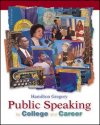A well-organized speech is more understandable, credible, and memorable than
a poorly organized one. The body of the speech should be organized with two or three (occasionally
four) main points that develop the central idea of the speech. Some guidelines
for main points: (1) Restrict each main point to a single idea. (2) Avoid announcements.
(3) Customize points for each audience. (4) Use parallel language whenever possible. Arrange the main points in a logical pattern, such as chronological, in
which main points are placed in a time sequence; spatial, in which items are
arranged in terms of physical space; causal, in which causes and effects are
juxtaposed; problem–solution, in which a problem is explained and a solution
offered; or topical, in which a central idea is divided into components. Next, select support materials to back up the main points, and then supply
transitions to help the listeners stay with you as you move from one part of
your speech to the next. Common types of transitions are bridges, internal summaries,
signposts, and spotlights. To simplify the task of organizing material, use one of these three options:
stick-on slips, computers, and cards. Put one item on each slip, computer entry,
or card so that you can easily add, delete, and rearrange your material. |



 2002 McGraw-Hill Higher Education
2002 McGraw-Hill Higher Education